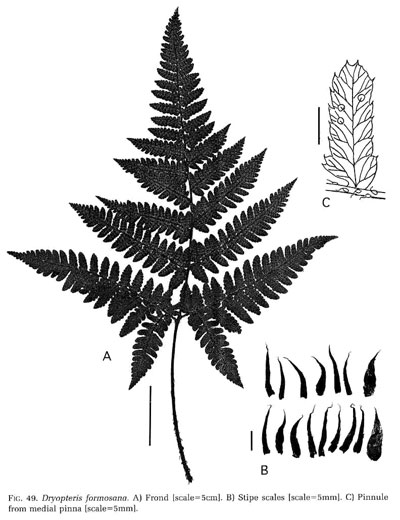| Dryopteris formosana | ||
|
Etymology
Formosana refers to the Island of Formosa, now called Taiwan.
Description
Rhizome: erect.
Frond: 100 cm high by 35 cm wide, evergreen in warmer areas, monomorphic, blade/stipe ratio: 3:2. Stipe: grooved, basal scales black-brown, to 1.5 cm, vascular bundles: 3-7 in a c-shaped pattern. Blade: 3-pinnate at the basiscopic pinnule, less divided upwards, pentagonal, papery, lanceolate or bullate, black scales on the rachis, tan scales on the costae. Pinnae: 13 to 15 pair, anadromous lowest pinnae pair, opposite; pinnules first basiscopic pinnule of basal pinnae very long, larger pinnules slightly eared; costae grooved above, continuous from rachis to costae; margins serrate, sometimes with two teeth at the end; veins free, forked. Sori: round, in 1 row between midrib and margin, indusium: reniform, at a sinus, sporangia: brownish. Culture
Habitat: floor of mountain forests.
Distribution: Japan, Taiwan and the Philippines.
Hardy to -20�C, USDA Zone 6.
Distinctive Characteristics
pentagonal frond and the long basiscopic pinnule
Synonyms
Aspidium formosanum H. Christ Polystichum constantissimum Hayata |
|
|
